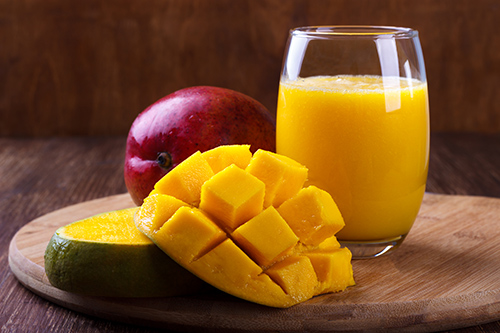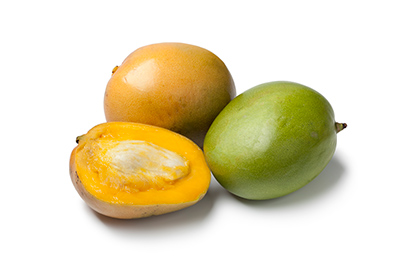Contents
Along with the many mango health benefits, the tree exemplifies tropical nature’s vitality. An average tree, about 65.62 ft in height, produces about four million blossoms yearly. Of these, only 250,000 will develop into fruit. This enormous fruit production has led natives in many tropical regions to consider the mango a natural pantry.
Considering that a mango tree lives for more than one hundred years, it is reasonable that it will produce more than two million pieces of fruit. Moreover, remember that this quantity is not at the expense of quality. Each mango is a masterpiece of nature for its aroma, delicate flavor, and dietary and therapeutic properties.

Mango Nutritional Facts
Mango pulp is water, somewhat less than peach or plum. Its carbohydrate content primarily consists of sugars (glucose, saccharose, and fructose). Unripe mangos contain some starch, which converts to sugar as the fruit ripens. Their proportion of proteins and fats is deficient. The most notable nutrients in the mango’s composition are:
Provitamin A – one hundred grams of mango contains significant amounts of vitamin A. Bearing in mind that the daily requirement of this vitamin is 1000 ug, therefore, a 300-gram mango alone provides the Recommended Dietary Allowance (RDA) of this crucial vitamin. The mango is the fresh fruit with the most significant vitamin A content, followed by the cantaloupe, although both are much below the carrot.
Sixteen types of carotenoids have been identified in the mango responsible for its vitamin A action. The most abundant of these is beta-carotene.
Carotenoids are vegetable pigments, generally yellow or orange, that convert to vitamin A within the body. Vitamin A is essential to maintaining epithelial tissues, such as the skin and the mucosa that line the body’s internal systems. Carotenoids are powerful antioxidants that counteract the oxidizing free radicals, which are molecules responsible for cellular aging.
Vitamin C – The mango is a good source of vitamin C. A medium-sized mango (300 grams) provides 138 percent of the adult daily requirement of this vitamin.
Vitamin E – A 300-gram mango provides 33 percent of the daily requirement for this vitamin for an adult male. This is one of the richest fresh fruits in this vitamin.
Mangos also contain non-nutritive components such as soluble fiber (pectin), organic acids (citric and malic), and tannins. To give an idea of the mango’s composition, 41 aromatic substances have been identified that combine to give this fruit its unique fragrance.
Mango Health Benefits

The following conditions are where the mango health benefits come in:
Skin conditions – Eating mangos helps maintain healthy skin. It has been proven that vitamin S deficiency produces skin dryness and scaling. Mangos contribute to proper skin hydration and tone. Eating large amounts of mangos is recommended in cases of eczema, dermatosis (skin degeneration), and skin dryness as a preventative for premature skin aging.
Retinal conditions – Vitamin A, whose action is potentiated by the simultaneous presence of vitamins C and E, is necessary for good vision. Mango consumption is recommended for vision loss due to retinal conditions such as night blindness, optic nerve atrophy, or thrombosis in the central retinal artery.
Arteriosclerosis – Mangos are rich in the three most potent antioxidant vitamins: A, C, and E. Each of these is potent in its own right, but much more so as a combined unit. They prevent the oxidation of the cholesterol-bearing lipoproteins that circulate in the bloodstream. The oxidation of these substances initiates cholesterol depositing on the arterial walls, leading to their deterioration.
Mangos are incredibly beneficial to the circulatory system. They should be included in the diet of all who experience poor blood circulation to the extremities or coronary arteries (angina or heart attack).
High Blood pressure – Mangos are diuretic (increase urine production). They are pretty rich in potassium and low in sodium. This makes them highly recommended in cases of hypertension since they aid in its control.
Diabetes – Diabetics can benefit from eating mangos because this fruit’s positive effect on the arteries helps prevent the circulatory complications associated with diabetes. These patients tolerate mangos well. It has been shown that after eating mangos, the blood glucose level of non-insulin-dependent diabetics is lower than expected.
Mango Scientific Facts

- Scientific name – Mangifera indica L.
- Other names – Man-gay, Mangga, man-kay.
- French – Mangue.
- Spanish – Mango.
- German – Mango.
- Description – Fruit of the mango, an evergreen tree of the botanical family Anacardiaceae, grows to 82.02 ft. The fruit is oblong with a thin yellow, orange, or greenish skin and a hard flat pit.
- Environment—The mango is native to India and Southeast Asia. It is cultivated in tropical regions of Asia, Africa, and America. The Portuguese introduced it to the Americas in the sixteenth century, taking it to Brazil. Brazil and Mexico produce the best mangos in the world.
How to Use and Prepare Mangos
- Fresh—This is the best way to eat mangos, but poor-quality mangos are very fibrous and have a robust turpentine flavor. The best have little fiber and a smooth, aromatic pulp reminiscent of a peach. Mangos are harvested green and stored well in the refrigerator for one to two weeks.
- Preserves – Mangos make jellies and jams and can be canned in syrup.
DISCLAIMER: All content on this website is presented solely for educational and informational objectives. Do not rely on the information provided as a replacement for advice, diagnosis, or treatment from a qualified medical expert. If you are pregnant, nursing, or have any preexisting medical concerns, talk to your doctor before using any herbal or natural medicines.
REFERENCES
- George D. Pamplona-Roger, M.D. “Encyclopedia of Foods and Their Healing Power.” George D. Pamplona-Roger, M.D. Encyclopedia of Foods and Their Healing Power. Trans. Annette Melgosa. Vol. 2. Chai Wan: Editorial Safeliz, 2005. 341, 342. Print.
- WebMD: https://www.webmd.com/diet/health-benefits-mango
- Healthline: https://www.healthline.com/nutrition/mango
- Cleveland Clinic: https://health.clevelandclinic.org/mango-benefits/
- Medical News Today: https://www.medicalnewstoday.com/articles/275921
Last update on 2025-05-15 / Affiliate links / Images from Amazon Product Advertising API




